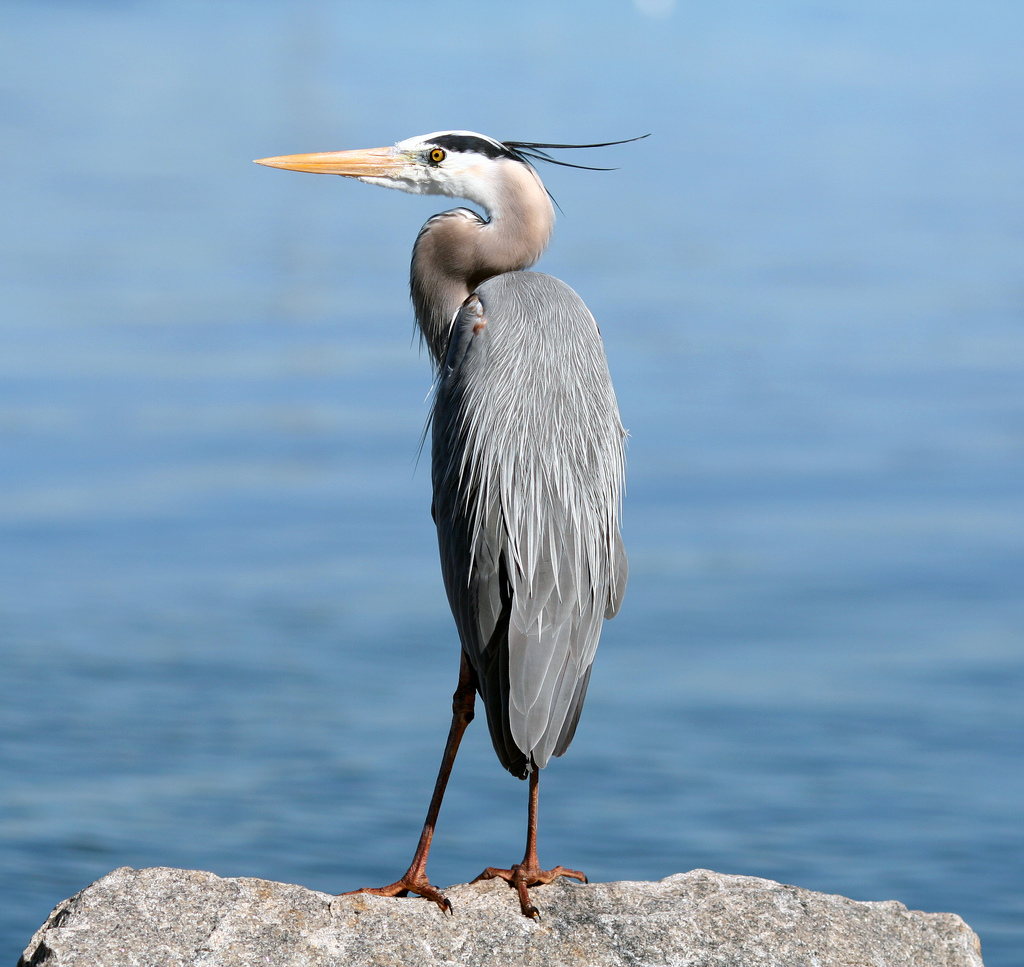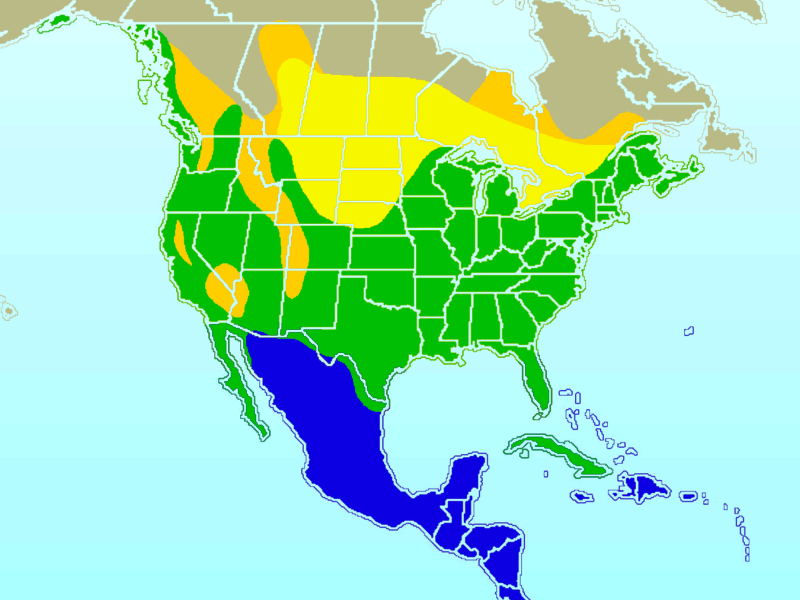- Great Blue Heron
Taxobox
name = Great Blue Heron
status = LC | status_system = IUCN3.1

image_caption =
image_width = 250px
regnum =Animal ia
phylum = Chordata
classis = Aves
ordo =Ciconiiformes
familia =Ardeidae
genus = "Ardea"
species = "A. herodias"
binomial = "Ardea herodias"
binomial_authority = Linnaeus, 1758
range_
range_map_width = 250pxThe Great Blue Heron , "Ardea herodias", is a wading
bird in theheron familyArdeidae , common over most of North andCentral America as well as theWest Indies and theGalápagos Islands , except for the far north and deserts and high mountains where there is no water for it to feed in. It is an extremely rare vagrant to Europe, with records from Spain, the Azores and England.It is the largest North American
heron , with a head-to-tail length of 91–140 cm (36-55 in), awingspan of 167-201 cm (66-79 in), and a weight of 2–3.6 kg (4.4-8 lbs). It is blue-gray overall, with blackflight feather s, red-brown thighs, and a paired red-brown and black stripe up the flanks; the neck is rusty-gray, with black and white streaking down the front; the head is paler, with a nearly white face, and a pair of black plumes running from just above the eye to the back of the head. The feathers on the lower neck are long and plume-like; it also has plumes on the lower back at the start of the breeding season. The bill is dull yellowish, becoming orange briefly at the start of the breeding season, and the lower legs gray, also becoming orangey at the start of the breeding season. Immature birds are duller in color, with a dull blackish-gray crown, and the flank pattern only weakly defined; they have no plumes, and the bill is dull gray-yellow.del Hoyo, J., Elliott, A., & Sargatal, J., eds. (1992). "Handbook of the Birds of the World" Vol. 1. Lynx Edicions, Barcelona ISBN 84-87334-10-5.] Sibley, D. (2000). "The Sibley Guide to Birds". National Audubon Society ISBN 0-679-45122-6] Dickinson, M. B. et al., eds. (1999). "Field Guide to the Birds of North America". National Geographic ISBN 0-7922-7451-2.]There are five
subspecies :
*"Ardea herodias herodias" Linnaeus, 1758. Most of North America, except as below.
*"Ardea herodias fannini" Chapman, 1901. ThePacific Northwest from southernAlaska south toWashington ; coastal.
*"Ardea herodias wardi" Ridgway, 1882.Kansas andOklahoma to northernFlorida .
*"Ardea herodias occidentalis" Audubon, 1835. Southern Florida,Caribbean islands.
*"Ardea herodias cognata" Bangs, 1903. Galápagos Islands.The subspecies differ only slightly in size and plumage tone, with the exception of subspecies "occidentalis", which as well as normal colored birds, also has a distinct a white morph, known as the Great White Heron. This was long thought to be a separate species, and is mainly found near salt water. Birds intermediate between the normal morph and the white morph are known as Wurdemann's Heron; in these only the head is white.
The call is a harsh croak; they are most vocal during the breeding season, but will call occasionally at any time of the year in territorial disputes or if disturbed.Listen |filename=Great Blue Heron.ogg |title=Great Blue Heron call |description=Four calls of the Great Blue Heron |format=
Ogg Habitat
The Great Blue Heron is found throughout most of North America, including
Alaska ,British Columbia ,Quebec ,New Brunswick andNova Scotia . The range extends south throughFlorida ,Mexico and theCaribbean toSouth America . Great Blue Herons can be found in a range of habitats, in fresh and saltwatermarsh es,mangrove swamps, flooded meadows, lake edges, orshoreline s, but they always live near bodies of water. Generally, they nest in trees or bushes near a body of water.Diet
The primary food for Great Blue Heron is small
fish , though they are also known to eatshellfish ,insect s,rodent s,amphibian s,reptile s, and small birds. [cite web | title = Hinterland Who's Who - Great Blue Heron | publisher = Canadian Wildlife Service | url = http://www.ffdp.ca/hww2.asp?id=43&cid=7 | accessdate = 2007-11-23] It is generally asolitary feeder. Individuals usually forage while standing in water, but will also forage in fields or drop from the air, or a perch, into water. As large wading birds, Great Blue Herons are able to feed in deeper waters, and thus are able to exploit a niche not open to most other heron species.It feeds in shallow water or at the water's edge during both the night and the day, but especially around dawn and dusk. Herons locate their food by sight and generally swallow it whole. Herons have been known to choke on prey that is too large. It uses its long legs to wade through shallow water, and spears
fish orfrog s with its long, sharp bill.Breeding
This species usually breeds in
monospecific colonies, in trees close to lakes or other wetlands; often with other species of herons.These groups are called
heronry (a more specific term than "rookery "). The size of these colonies may be large, ranging between 5–500 nests per colony, with an average of approximately 160 nests per colony.Great Blue Herons build a bulky stick nest, and the female lays three to six pale blue eggs. One brood is raised each year. If the nest is abandoned or destroyed, the female may lay a replacement clutch.
Reproduction is negatively affected by human disturbance, particularly during the beginning of nesting. Repeated human intrusion into nesting areas often results in nest failure, with abandonment of eggs or chicks.Both parents feed the young at the nest by regurgitating food. Parent birds have been shown to consume up to four times as much food when they are feeding young chicks than when laying or incubating eggs.
Eggs are incubated for approximately 28 days [ [http://www.mbr-pwrc.usgs.gov/id/framlst/i1940id.html Great Blue Heron ] ] and hatch asynchronously over a period of several days. The first chick to hatch usually becomes more experienced in food handling and aggressive interactions with siblings, and so often grows more quickly than the other chicks.
Migration
Birds east of the
Rocky Mountains in the northern part of their range are migratory and winter inCentral America or northernSouth America . From thesouthern United States southwards, and on thePacific coast , they are year-round residents. However their hardiness is such that individuals often remain through cold northern winters, as well.
Wikimedia Foundation. 2010.



_in_flight.jpg|In_flightImage:GreatBlueHeronVictoria.jpg)


 Neck_extendedImage:Great_blue_heron-20080119.jpgImage:Great_Blue_Heron_Portrait.jpg|A_Great_Blue_Heron_at_a_beach_in_Tarpon_Springs,_FloridaImage:Heronry.jpg|A_rookery_may_contain_up_to_500_nests.Image:Ardea_herodias6.jpg|Three_Great_Blue_Heron_chicks_with_parents_in_nestImage:Great_blue_heron_-_natures_pics.jpg|Flight_is_strong,_with_slow,_regular_strokes.Image:Ardea_herodias,_Feb.,_Ontario.jpg|February_river,_London,_Ontario,_resident_showing_winter_hardinessImage:Nest_of_Ardea_herodias_.jpg|The_nest._The_chick_on_the_right-hand_side_is_showing_his_
Neck_extendedImage:Great_blue_heron-20080119.jpgImage:Great_Blue_Heron_Portrait.jpg|A_Great_Blue_Heron_at_a_beach_in_Tarpon_Springs,_FloridaImage:Heronry.jpg|A_rookery_may_contain_up_to_500_nests.Image:Ardea_herodias6.jpg|Three_Great_Blue_Heron_chicks_with_parents_in_nestImage:Great_blue_heron_-_natures_pics.jpg|Flight_is_strong,_with_slow,_regular_strokes.Image:Ardea_herodias,_Feb.,_Ontario.jpg|February_river,_London,_Ontario,_resident_showing_winter_hardinessImage:Nest_of_Ardea_herodias_.jpg|The_nest._The_chick_on_the_right-hand_side_is_showing_his_